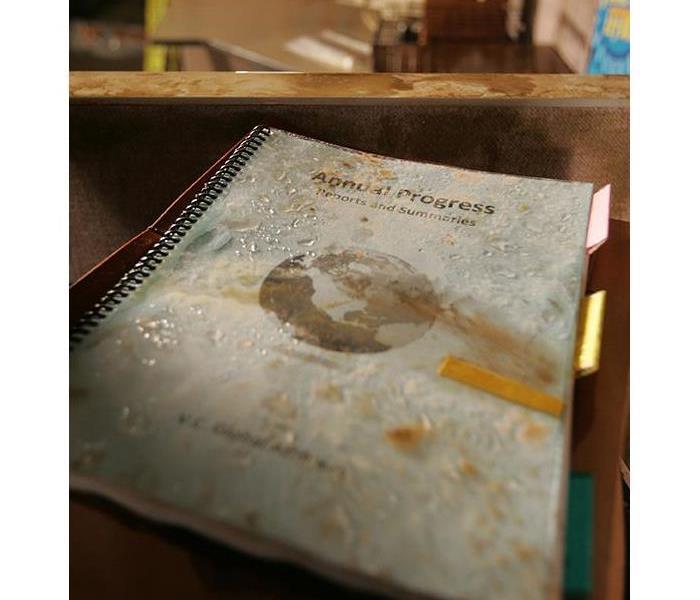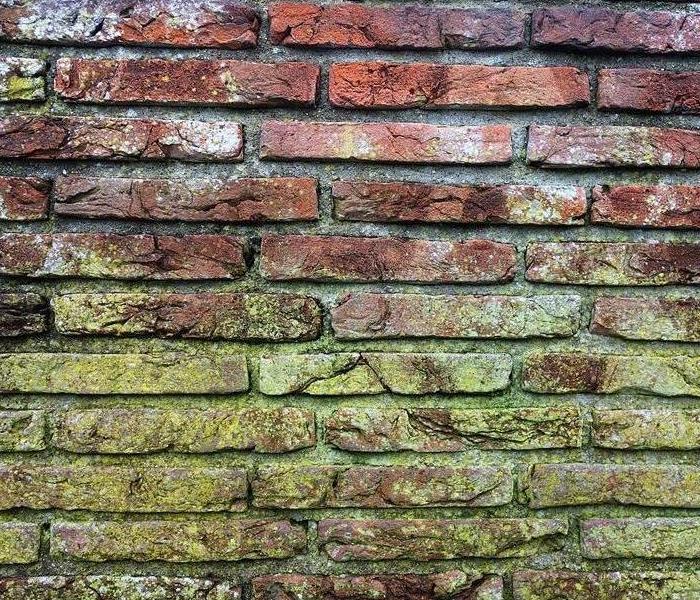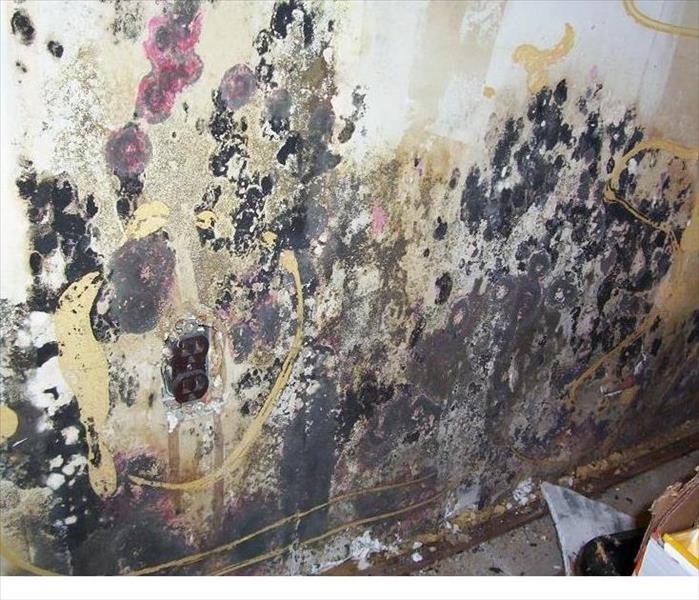Archived Mold Remediation Blog Posts
How to Tackle Mold Season and Prevent Mold Growth
5/2/2024 (Permalink)
 An example of mold on a painted wall in a home.
An example of mold on a painted wall in a home.
As we transition into warmer, more humid months here in Connecticut, we experience what can be dubbed as "mold season." This period brings with it the increased risk of mold growth in homes, offices, and other indoor spaces. Mold not only poses health risks but can also damage property and belongings if left unchecked. Here are some tips to help you prevent mold growth and deal with it effectively:
1. Control Moisture: Mold thrives in moist environments, so keeping indoor humidity levels low is key. Use dehumidifiers, air conditioners, and exhaust fans to regulate moisture levels, especially in areas prone to dampness like bathrooms and basements.
2. Ventilation: Proper ventilation is essential to prevent moisture buildup. Ensure good airflow by opening windows, using exhaust fans, and installing vents in kitchens and bathrooms.
3. Address Leaks Promptly: Any leaks in pipes, roofs, or windows should be fixed promptly to prevent water from seeping into walls, ceilings, and floors, creating ideal conditions for mold growth.
4. Monitor Indoor Humidity: Invest in a hygrometer to monitor indoor humidity levels regularly. Aim for humidity levels between 30-50% to discourage mold growth.
5. Clean Regularly: Regular cleaning can help prevent mold growth by removing spores before they have a chance to colonize. Pay special attention to areas prone to moisture, such as bathrooms, kitchens, and laundry rooms.
6. Use Mold-Resistant Products: When renovating or building, consider using mold-resistant materials such as mold-resistant drywall, paint, and insulation.
7. Inspect HVAC Systems: Ensure that your heating, ventilation, and air conditioning (HVAC) systems are clean and functioning properly. Dirty or malfunctioning HVAC systems can circulate mold spores throughout your home.
8. Remove Mold Promptly: If you do find mold, it's essential to address it promptly. It's best to consult with professionals who specialize in mold remediation.
By taking proactive steps to prevent mold growth and addressing any issues promptly, you can keep your indoor spaces healthy and mold-free, even during mold season. Remember, a little prevention can go a long way in safeguarding your home and your health.
If you discover mold at your residence or business, call SERVPRO of Manchester/Mansfield at anytime. 860-633-8791 We're here 24/7.
SERVPRO of Glastonbury/Wethersfield
IICRC Certified
Noemi Garcia
Franchise Owner
Call 860.633.8791
24-hour emergency service
When Your Belongings Are Damaged by Mold
1/25/2019 (Permalink)
 Documents and photos are among the important water- and mold-damaged possessions SERVPRO of Glastonbury/Wethersfield can restore.
Documents and photos are among the important water- and mold-damaged possessions SERVPRO of Glastonbury/Wethersfield can restore.
Water and mold damage can affect not only the structure of your house but also your belongings. SERVPRO of Glastonbury/Wethersfield understands that mold damage to your family’s furniture, clothing, keepsakes and other belongings needs to be restored just as thoroughly as your home’s structure.
Contents Restoration
SERVPRO of Glastonbury/Wethersfield specializes in restoring contents damaged by fire, water or mold. Our “restore” versus “replace” mentality can help you save money while preserving precious keepsakes. We first test your contents to determine what items can be restored back to their pre-damaged condition. We use several methods to clean your possessions, including:
- Dry cleaning: used to clean light residues or to pre-clean prior to wet cleaning.
- Wet cleaning: effective for removing moderate to heavy residues.
- Spray and wipe: for items that can’t withstand wet cleaning.
- Foam cleaning: used for upholstery fabrics that might shrink or bleed if wet cleaned.
- Abrasive cleaning: involves agitation of the surface being cleaned.
- Immersion cleaning: contents are dipped into a bath of the cleaning product.
For professional mold remediation of your home and its contents, call SERVPRO of Glastonbury/Wethersfield today at 860.633.8791
Electronic Cleanup
Water- and mold-damaged electronics can present a serious hazard–do not attempt to turn on or operate any electrical device that you suspect has been damaged by water! Your electronics will be cleaned and inspected by a qualified SERVPRO of Glastonbury/Wethersfield electronics technician. Among the electronic devices we restore are:
- Television sets
- DVD players
- Computers and tablets
- Phones
Document / Photograph Drying
We take extreme caution to make sure water or mold damage does not destroy your valuable documents, such as photographs. Although some documents may never be restored to pre-water damage condition, SERVPRO of Glastonbury/Wethersfield can save a great deal and help minimize additional damage.
Depending on the type of documents and the level of water and mold damage, we use five methods for the restoration of documents:
- Air drying
- Dehumidification
- Freezer drying
- Vacuum freeze drying
- Vacuum thermal drying
Contents Claim Inventory Service
If you need mold remediation of your possessions, our Contents Claim Inventory Service (CCIS) can help ease worry and confusion during the recovery process. We provide a detailed and accurate list of your belongings, beginning with a room-by-room inventory of your contents, including digital photos, and in some instances, bar coding.
For professional mold remediation of your home and its contents, call SERVPRO of Glastonbury/Wethersfield today at 860.633.8791
Our Contents Claim Inventory Service includes:
- Pre-loss list and value of contents
- Detailed and accurate report
- Better information quicker claims settlement
- Assistance with burden of proof for claims
Move-Outs/Pack-Outs
If your home requires extensive restoration or cleaning, SERVPRO of Glastonbury/Wethersfield can conduct an organized, efficient move-out of the affected area. A move-out allows for a quicker remodeling process while it protects your possessions from potential damage.
When the restoration is completed, we will coordinate the move-in. The services offered upon move-in may depend on your insurance coverage.
We’re Here to Help
When your personal belongings are damaged by mold, call a professional with a solid record of providing mold remediation in the Connecticut region: SERVPRO of Glastonbury/Wethersfield at 860-633-8791, around the clock. At SERVPRO®, we know the safest, quickest and most effective ways to help you remove mold contamination from your commercial or residential property.
Other Helpful Blog Posts
Every month on the SERVPRO of Glastonbury/Wethersfield blog we publish educational articles on how Glastonbury and Wethersfield residents can protect their homes and businesses from disasters and how to deal with mold, fire, water, sewage, storm and other damage.
We’re Here for You
SERVPRO of Glastonbury/Wethersfield
We serve East Glastonbury, Glastonbury, Marlborough, Portland, Rocky Hill, South Glastonbury and Wethersfield, Connecticut.
SERVPRO of Glastonbury/Wethersfield
IICRC Certified
Noemi Garcia
Franchise Owner
Call 860.633.8791
Fax 860.216.2762
24-hour emergency service
Why Bleach Isn't The Answer For Fighting Mold
10/16/2018 (Permalink)
 There are much better ways to get rid of mold than using bleach
There are much better ways to get rid of mold than using bleach
Got mold? It’s a common issue. And most people think the common answer of using bleach to get rid of mold is the best answer. Wrong. We’re about to give you four major reasons why bleach is not the most effective choice to rid your home or business of mildew or mold.
1. Bleach won’t kill mold on porous surfaces. It may even help mold grow.
Yes, chlorine bleach can kill surface mold. But mold can grow deep roots within porous surfaces including drywall and wood. Those roots will not be affected by bleach. The bleach you apply remains on the surface while the water in the bleach goes deeper and can feed the mold growth.
2. Bleach loses its effectiveness over time.
Do you know how old the bleach is that you’re using? That’s important because chlorine bleach rapidly loses its effectiveness. Try leaving a glass of chlorinated water out on the counter for a few days. You’ll find the chlorine will evaporate. This happens within bleach containers as well. Evaporation means that it will be hard for you to determine the true potency of your chlorine bleach solution because the chlorine can escape through plastic. Perhaps the chlorine bleach you’re using has been sitting at the store, or in your home for months or longer. That will lessen its power to perform.
For Mold, Fire & Water Cleanup & Restoration Call SERVPRO of Glastonbury/Wethersfield At (860) 633-8791
3. Bleach is toxic.
Chlorine bleach produces fumes that pollute the air and can become harmful to humans and pets. Chlorine bleach also generates a by-product called dioxin, which is linked to cancer. If you use bleach over time you can build up these pollutants in your environment.
4. OSHA and the EPA recommend not using bleach to kill mold.
The Occupational Safety and Health Administration (OSHA), stopped recommending the use of bleach for dealing with mold problems. And, the Environmental Protection Agency (EPA) updated their guide as well, removing the suggestion to use bleach to kill mold.
For Mold, Fire & Water Cleanup & Restoration Call SERVPRO of Glastonbury/Wethersfield At (860) 633-8791
So, bleach can kill surface mold but it won’t touch the roots. You can use bleach to temporarily kill what’s on the surface but treating mold with bleach alone is not effective in the long run. You won’t know how potent the bleach you use is and using it means exposing yourself to harmful fumes. And major consumer protection organizations do not recommend bleach.
Get Rid of Mold Issues for Good
Specialists in professional remediation can be your best bet when it comes to getting rid of mold for good. Our crews at SERVPRO of Glastonbury/Wethersfield use special cleaners and equipment to get rid of mold, including spores. We can identify the full extent of your mold infestation and treat mold-infested areas safely and effectively.
More Information
SERVPRO of Glastonbury/Wethersfield publishes educational articles on how Glastonbury area residents and businesses can protect themselves from mold and natural disasters and restore their property after a flood, sewage spill, fire, or other harmful event. We also try to give you ideas about resources in the greater Glastonbury and Wethersfield community. Here are a few blog posts you might find helpful:
Contact Us Anytime
In Glastonbury the team at SERVPRO® has specialized training and experience in water damage restoration services, fire damage restoration services, mold remediation, commercial services, and natural disaster cleanup. Call SERVPRO of Glastonbury/Wethersfield anytime at 860.633.8791.
SERVPRO of Glastonbury/Wethersfield
IICRC Certified
Noemi Garcia
Franchise Owner
Call 860.633.8791
Fax 860.216.2762
24-hour emergency service
7 Ways To Prevent Mold
8/22/2018 (Permalink)
 You can greatly reduce the chance of mold damage by taking some simple steps
You can greatly reduce the chance of mold damage by taking some simple steps
Mold spores love to spread and they do easily. No matter how great you clean you cannot get rid of all mold. Adding to the problem is that mold can grow anywhere--carpet, clothing, food, paper, and in places you can't see like the backside of drywall, areas inside walls around leaking or condensing pipes, and above your home’s ceiling tiles. Here are some ideas:
1. Equip your home with mold-resistant products.
Building a new home or renovating an old one? Use mold-resistant products like mold-resistant drywall or mold-resistant sheetrock, and mold inhibitors for paints. Traditional drywall is composed of a gypsum plaster core pressed between plies of paper. Mold-resistant drywall is paperless — the gypsum core is covered in fiberglass, making the surface highly water-resistant. Moisture-resistant drywall is especially valuable in areas prone to wetness, such as bathrooms, laundry rooms, basements, and kitchens.
Not only is traditional drywall more susceptible to mold than the paperless kind, but it is also difficult to rid of mold, and removal and replacement can be expensive. Mold-resistant gypsum board is also available; the core of the drywall is developed in such a way to prevent moisture absorption, and thus prevent mold growth.
Questions about mold or mildew? We’re experts. Call SERVPRO of Glastonbury/Wethersfield at 860.633.8791
2. Monitor humidity indoors.
The EPA recommends keeping indoor humidity between 30 and 60 percent. You can measure humidity with a moisture meter purchased from your local hardware store. You'll also be able to detect high humidity by simply paying attention to potential problem areas in your home. Telltale signs of excessive humidity include condensation on windows, pipes, and walls. If you notice condensation, dry the surface immediately and address the source of moisture (for example, turn off a humidifier if water appears on the inside of nearby windows).
3. Direct water away from your home.
If the ground around your home isn't sufficiently sloped away from the foundation, water may collect there and seep into your crawlspace or basement.
4. Freshen your fabrics and upholstery.
Avoid sending mold spores into the air and throughout the house by first taking fabric and upholstery that's mobile outside. Brush off as much of the mildew as possible. Then treat these pieces individually as follows.
• Fabric should be laundered in chlorine bleach and hot water. If chlorine bleach is not a safe option for the material, soak it in oxygen bleach and hot water for a half hour, then wash as directed. Take it outside to dry in the sun if possible.
• Upholstery that you can't take outside should be vacuumed first. Replace the vacuum bag or take the canister outside to clean. Then mix 1 cup of ammonia with 1 cup of cool water. (Chlorine bleach and ammonia should never be combined due to the resulting toxic fumes.) Using a clean white cloth, sponge the stains with the ammonia solution. Blot until all the liquid is absorbed. Repeat the process until the stain disappears. To remove the resulting ammonia solution, sponge the area with cold water and blot. Dry thoroughly with a fan or hair dryer set on cool.
Questions about mold or mildew? We’re experts. Call SERVPRO of Glastonbury/Wethersfield at 860.633.8791
5. Clean or repair roof gutters.
A mold problem might be a simple matter of a roof that is leaking because of full or damaged gutters. Have your roof gutters cleaned regularly and inspected for damage. Repair them as necessary, and keep an eye out for water stains after storms that may indicate a leak.
6. Improve air flow in your home.
According to the EPA, as temperatures drop, the air is able to hold less moisture. Without good air flow in your home, that excess moisture may appear on your walls, windows and floors. To increase circulation, open doors between rooms, move furniture away from walls, and open doors to closets that may be colder than the rooms they’re in. Let fresh air in to reduce moisture and keep mold at bay.
7. Keep mold off household plants.
They're beautiful and help keep your indoor air clean — and mold loves them. The moist soil in indoor plants is a perfect breeding ground for mold, which may then spread to other areas of your house. Instead of getting rid of your plants, try adding a bit of Taheebo tea to the water you give to your houseplants. The oil of this tree, which withstands fungi even in rain forests, helps hinder mold growth in plant soil and can be found at natural food stores.
Bonus: Learn your local climate.
Finally, educate yourself on your region's climate — be it the cold and wet Northeast, the hot and wet South, the hot and dry Southwest, or the cold and dry West — and how it responds to moisture. There is no one-size-fits-all solution when it comes to mold prevention. Knowing what works for your climate and your home is an important first step.
Help Is Here
Questions? Call SERVPRO of Glastonbury/Wethersfield to discuss. Call 860.633.8791. We’re the mold, mildew, and water removal service professionals who have saved property and saved money for the owners of flooded basements and water damaged properties. We serve homeowners and business owners in Glastonbury, Marlborough, Portland, Rocky Hill, and Wethersfield.
SERVPRO of Glastonbury/Wethersfield
IICRC Certified
Noemi Garcia
Franchise Owner
Call 860.633.8791
Fax 860.216.2762
24-hour emergency service






 24/7 Emergency Service
24/7 Emergency Service



